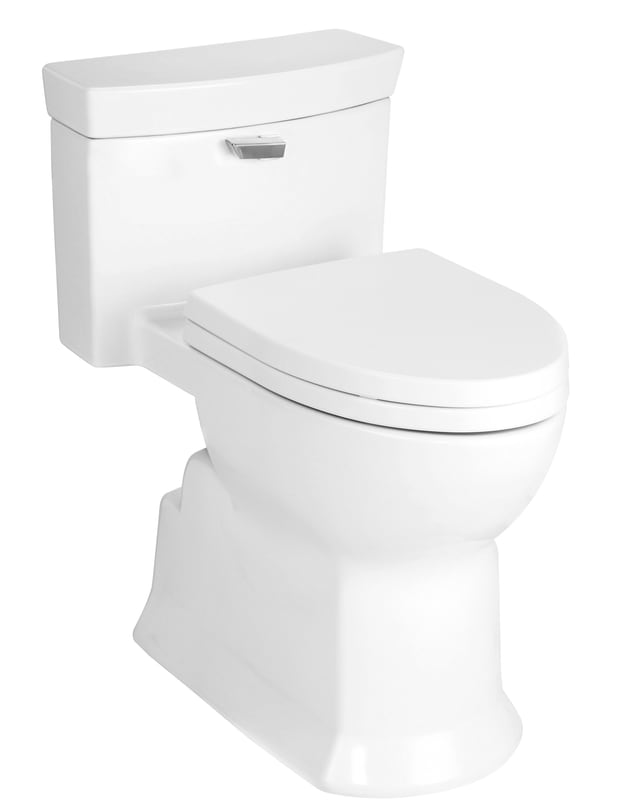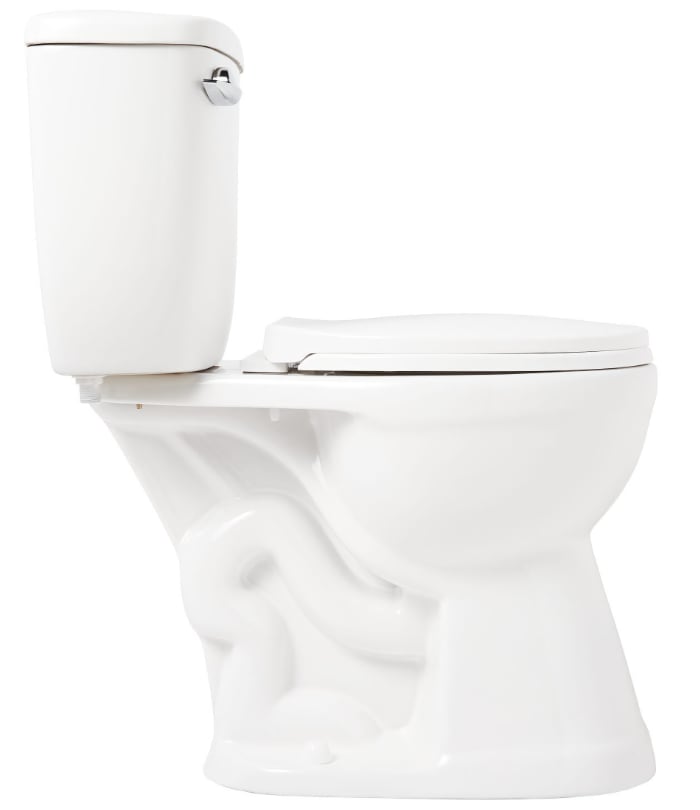If you’re purchasing a brand new toilet, you may see the terms washdown and siphonic used fairly often and the product details, but what does this mean? And more importantly, why should you care?
Siphonic and washdown toilets are two completely different flushing technologies that affect the overall performance of your toilet. So when it comes to a siphonic vs washdown toilet, which is the better pick?
What are Siphonic Toilets?
Personally, I’ve always found that siphonic toilets are the best go-to option for toilets. You’ll also find that they’re more popular in the US.
How do they work?
The distinguishing characteristic of siphonic toilets is their S-shaped trapway. This practical trapway shape slows down the speed of the water as it leaves the toilet bowl. Most toilet designs today will have a fully glazed trapway.
The glaze (which is located on the exterior as well) not only protects the toilet’s surface from bacteria and dirt but it allows water to more easily flow through the trapway, reducing the number of clogs that a toilet may experience.
When the flush lever is pressed, the water quickly exits the tank and the bowl and displaces the air inside the trapway.
After a flushing session, the water level in a siphonic toilet sits at a higher level above the outlet hole compared to a washdown model. The purpose of that water is to form a seal that prevents odor from the sewer system from finding its way back to the bathroom.
Also, siphon toilet bowls happen to be bigger-somewhere around 7’’ x 8’’. If you are limited on bathroom space, the long trapway and bowl on this toilet may not be ideal. However, there are shorter models available for these toilets.
As a result, the water forms a vacuum, creating a siphoning mechanism that allows the toilet bowl and tank to quickly refill with fresh water. Syphonic toilets have a larger flush valve that diameter but a more narrow trapway than washdown toilets.
This allows for a powerful and strong flush, which is ideal for removing heavy solid waste. For this reason, you’ll find that these toilets are less likely to leave behind bowl streaks or cause bathroom odor.
Features
- Trapway is smooth, narrow, and S-shaped
- Has a strong flush which minimizes waste residue
- The toilet bowl base is longer
- Toilet bowl has a high water level
Benefits
- On average, the toilet bowl remains cleaner
- Is less prone to have an odor in the bowl
- The flush isn’t as loud as other toilets
Drawbacks
- The narrow trapway can make clogging more common
- Works better with elongated toilet bowls, which may not be ideal for smaller bathrooms
What Are Washdown Toilets?
Washdown toilets work a bit differently, and you may not find these as commonly in US markets as siphonic toilets. However, many European toilets are made using this type of toilet flush system.
How do they work?
Washdown toilets have a shorter trap way which is typically about four inches wide (which is about twice the size of the siphonic toilet). When the push button is pressed, the water pours out of the tank to the bowl and washes away liquid or solid waste out of the wider trapway.
Washdown toilets use the gravitational flow and weight of the water within the tank to flush out waste from inside the toilet bowl.
So with this type of toilet system, the heavy pressure of the water flowing out of the tank creates the flushing mechanism — which is a big reason why they tend to clog less often.
However, on the downside, they are known to hold odor and have more bowl streaking. Sure, you can quickly get rid of the bowl streaks with a toilet brush, but who really wants to do that?
This is due to their shallow bowl base and narrow water surface. When solid waste enters the bowl it’s not completely submerged in water, which can allow order to instantly permeate the air if it isn’t flushed immediately.
One of the biggest ways to prevent this is to either do a quick “courtesy flush” or even a few follow-up toilet flushes if needed. Also, many washdown toilets come with dual-flushing systems that allow for water-preservation.
With these types of systems, you have one button for liquid waste and another button for solid waste.
Features
- The trapway is wider and shorter
- The total water surface area is smaller
- More often will have a flush push-button instead of a lever
- Many include a dual flush button for better water efficiency

Benefits
- Are less likely to clog and can handle larger waste loads (and toilet paper clogs)
- A fairly easy to clean and maintain
- Use less water on average
- Have a short bowl base, which can be a space saver
Drawbacks
- Are more prone to bad odors
- Has a loud flush, which can be jarring
- The low water level makes splashing more common
Siphonic vs Washdown Toilet
When it comes to selecting toilet tanks, wash down, and siphonic toilets are typically the most common.
Once you narrow down options to these two, you’ll simply need to consider your household size, dynamic, and overall toilet preference to determine which option will work best.
Which one is better?
If we’re going to do a full matchup of a siphonic vs washdown toilet, it’s best to do a side-by-side comparison.
This way you can get a quick glance at the main differentiators. If you’re still unsure about which toilet is best for you, take a look at the main features that come with each of them.
| Feature | Siphonic Toilet | Washdown Toilet |
|---|---|---|
| Area of water surface | Wider | More Narrow |
| Maintenance requirements | Require more effort | Pretty Easy |
| Trapway shape | Narrow and Longer | Wider but short |
| Size of toilet bowl base | Wider and longer | More on the shallow side |
| Odor proneness | On the low side | More likely |
| Clog tendency | Higher | On the lower side |
| Waste residue | Minimal residue | More common |
Conclusion
As you can see, a siphonic toilet may be more beneficial if you prefer a quieter toilet and are less prone to waste odors.
But if you prefer a toilet that can handle more waste but with minimal clog propensity, a wash down may be a better pick. Check out our article to learn more about different types of toilet flush systems.

